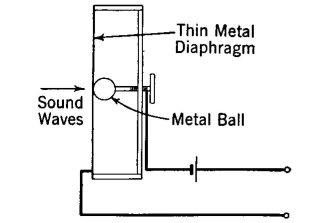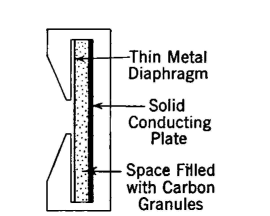| Electrical Communication is a free textbook on the basics of communication technology. See the editorial for more information.... |

|

Home  Early History of Electrical Communication Early History of Electrical Communication  The Development of Telephone Service The Development of Telephone Service |
||||||






|
||||||
The Development of Telephone ServiceThe first telephone switchboards were modeled after the then-existing telegraph boards. In some of these the party to be called was signaled by a buzzer arrangement causing the distant receivers to give out a grating sound.17 This receiver, in addition to fulfilling the signaling function, also served as a magneto transmitter. The "Universal" and "Standard" switchboards were introduced in 1879 and 1880 respectively. Other switchboards and many important changes were adopted in the years following.7, 17
Until about 1891 almost all telephones were operated with local batteries at each set to supply the transmitter current, and with hand generators for signaling purposes. An important advance was the common-battery switchboard developed18 from the fundamental inventions of Carty. This switchboard employed one battery at the central office for all the telephone sets connected. The first common-battery switchboard was installed in Lexington, Massachusetts, in 1893. The so-called automatic systems (now called dial telephone systems) early received the attention of inventors, and in 1879 a patent on such apparatus was applied for by the Connellys and McTighe.17 Many interesting switching systems were developed during this period.19 The step-by-step dial system was invented by Strowger about 1887 and patented in 1889. It was developed by Keith and others and was further perfected by Bell System engineers. This equipment was first used commercially at LaPorte, Indiana, in 1892. The panel-type dial system was developed by the Bell System early in this century. The rotary dial system was developed at about this same time and is widely used abroad. The crossbar dial system was developed about 1935.
The development about 1881 of the two-wire metallic circuit eliminating the earth return is credited to Carty. Carty did much of the early work on inductive interference18 and developed methods for transposing circuits in 1891. He is also considered the inventor11 of the phantom circuit. The first transposition system was devised by Barrett, in 1885. The introduction of cable was an event of importance. It is stated7 that Bell early conceived the idea of cables. Probably the first cables used for telephone service7 were laid across Brooklyn Bridge in 1879. These were insulated with rubber or gutta-percha. Some early cables were insulated with oil. The insulation of all these cables had a high dielectric constant, and the cable capacitance was accordingly higher than desirable. Cotton cloth impregnated with paraffin was also used to insulate the wires. In the early cables the cores were first made and then pulled into the cable sheath. About 1890 the first "dry-core" cables were made, the insulation for each conductor consisting of a dry paper tape wound around the conductor. These insulated wires were formed into a core, and the lead sheath then pressed around the core by a continuous process. About 1940 a transcontinental telephone cable system was completed. One of the greatest of all improvements in telephone transmission was the development and application of loading in 1899 and the years immediately following. The theory of loading is largely due to Heaviside, Pupin, and Campbell. Inductance was added to the lines at regular spacings to improve the transmission characteristics, and this application greatly extended the talking distances. Prior to the use of loading, commercial service could be given over no greater distance than from New York to Chicago; with loading, service was possible from New York to Denver by 1911. Two important developments were the telephone repeater and the carrier telephone system. The vacuum-tube amplifier was invented by de Forest; it was adapted to telephone-line repeater operation by Bell System engineers, particularly by Arnold. The repeater using vacuum tubes was preceded by the Shreeve mechanical repeater, which, although it was used in a limited way, was not entirely satisfactory. It was the vacuum-tube repeater (first used experimentally21 in 1913) that made possible the operation of the first transcontinental telephone circuits opened for commercial service in 1915. This was perhaps the first extensive commercial use of the vacuum-tube amplifier. The carrier-telephone system (sometimes called a multiplex system) was developed by Bell System engineers, and was first used in 1918.
|
||||||
Home  Early History of Electrical Communication Early History of Electrical Communication  The Development of Telephone Service The Development of Telephone Service |
||||||
Last Update: 2011-06-06



